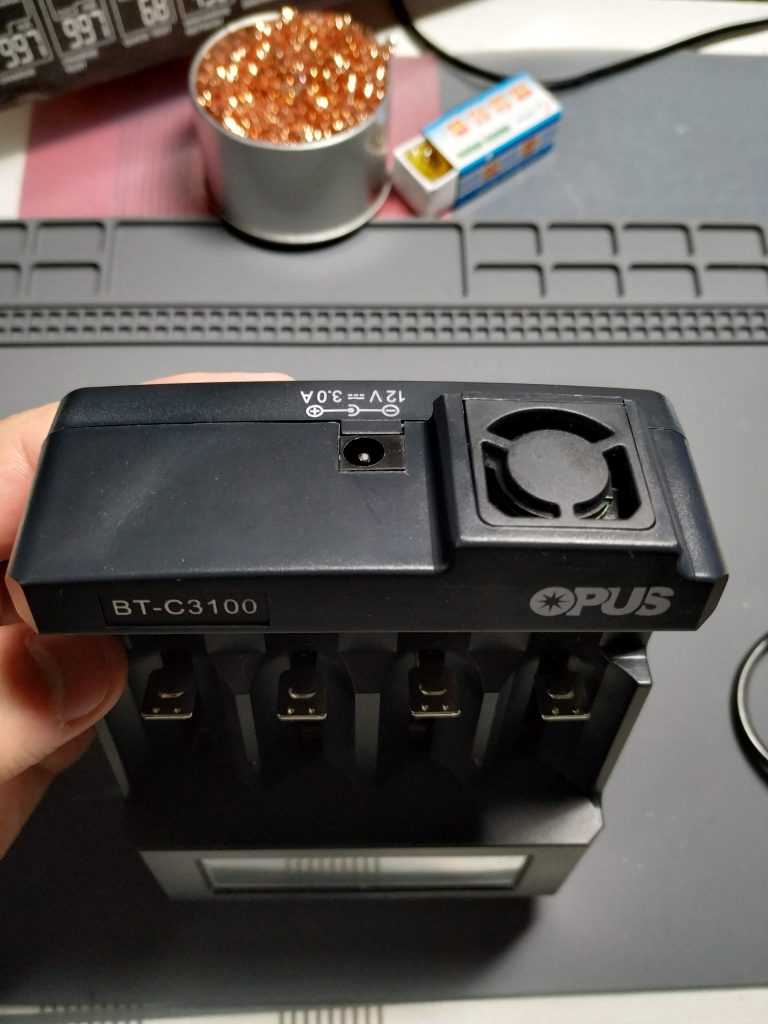Hi guys!
In this area we will show one of the best chargers for lithium batteries on the market. This is the Opus BT C3100.
Where to buy, price and shipping of Opus BT C3100
- I leave you link from the seller where I bought it: buy Opus BT C3100
There are several vendors in aliexpress who sell this same item. In my case the order has arrived in 3 weeks and I paid 31€ (the price fluctuate a lot over time).
Package photos
Let’s put some pictures of what we received in the package:


You can see the buttons so that we can change the operating mode, the data displayed on the screen, change the loading/download intensity and select the bay that we need to change the settings.

Obviously the cells I’ve put in, they don’t come in the package, xD. As you can see, the connector adjusts to the size of the cells. It is a very convenient system to use.

You can see the fan, below we talk about it (and not well precisely).

The characteristics indicated by the manufacturer are as follows:
- Brand: Opus
- Model: BT-C3100 V2.2
- Compatible with:AA (LR6) and AAA (LR3) NiCd, NiMH or 3.7V Li-ion rechargeable in type size of 10440, 14500, 16340, 17335, 17500, 18490, 17670, 186500
- Number of slots: 4
- LCD display: Yes
- Maximum load capacity: Up to 20000mAh
- Operating temperature: 0 – 40 degrees C
- Input Voltage: AC 100 x 240V 50 / 60HZ
- Power Adapter: DC 12V, 3.0A (Output), 100 – 240V, 50/60Hz (Input)
- Protections:
- Automatic circuit detection: Yes
- Built-in protected circuit: Yes
- Surge protection: Yes
- Short-circuit protection: Yes
- Overload protection: Yes
- Protection against excessive downloads: Yes
- Package weight: 0.558 kg
- Product size (L x W x H): 14.4 x 9.8 x 3.9 cm / 5.66 x 3.85 x 1.53 inches
Experience using the Opus BT C3100
After using it for quite some time, I have to say that it is an almost round product.
It’s good for both nickel and Lithium cells. This means that we can use it for typical AA or AAA rechargeable batteries, or for lithium cells of multiple sizes (such as Liitokala’s NCR18650B battery).
The charger itself detects when we put a cell in it, what type it is (lithium or nickel), and adjusts the charging voltage automatically.
It has several operating modes that can be configured independently for each bay:
- Charge: The most common mode. Simply load the cell to the maximum.
- Discharge: This mode is valid to unload the cell to a minimum, always keeping the recommended values for each cell type.
- Load refresh: This is a mode that is used when a cell has been standing for a long time. What it does are 3 full loads and discharges, to “revive” the cell. Sometimes some capacity is recovered.
- Capacity Test: What it does is to max the cell, then download it, and calculate the actual cell capacity. This is a very useful test when we want to know the degradation that a cell has suffered. We can see an example in the entry Liitokala cell NCR18650B capacity test.
- Internal resistance test: It is a test that is performed very fast. What the Opus does is apply a shock to the cell, and calculate what the voltage drop the cell suffers. With that value and formulas, it calculates its internal resistance in mOhm. This is useful for knowing the health status and quality of a cell. The lower the internal resistance, the more efficient the cell, and the more life it has left.
Another point to note is that regardless of the way you select, you can choose the intensity you want to use (less in the internal resistance test). Allowed values are 200, 500, 1000, 1500, and 2000mA. Point out, that 1500 and 2000mA modes are available only when we put a maximum of 2 cells, and only apply to loads. When you apply unloads, the maximum it gives is 1000mA per cell.
Points where it can improve the Opus BT C3100
Since it couldn’t be all perfect, let’s put a negative point in it. It has a fan that makes some noise, and also vibrates a little. This can be annoying. Despite this small fan, the charger heats up quite a bit, especially when we have the 4 bays unloading cells at maximum intensity. It even temporarily stops the discharges so that the cells cool a little bit (it has temperature sensors to protect the cells). It’s not a problem either, it’s just a point where it could get better.
I hope the article was helpful to you.
Any doubts leave it in comments.
Until the next entry!! Best regards!
